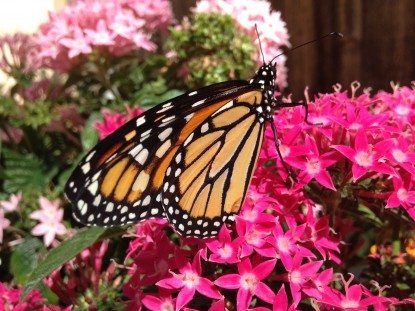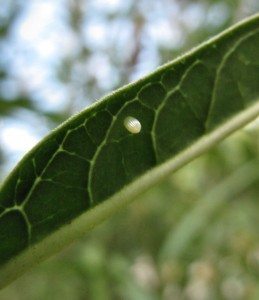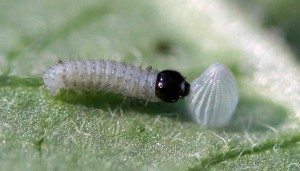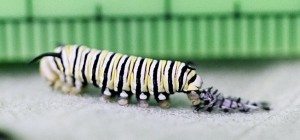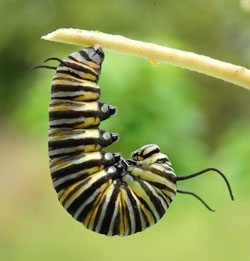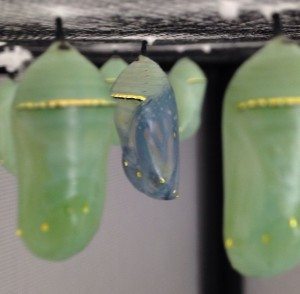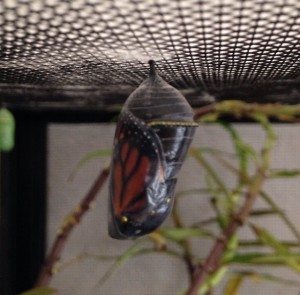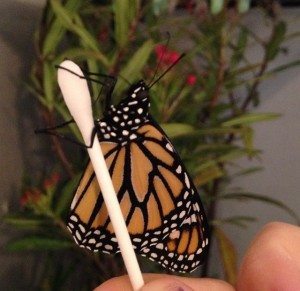Raising Monarch Butterflies
First thing’s first: You will need a milkweed plant. This is the butterfly host plant where the females will lay their eggs underneath the leaves. Very important–make sure your plant is ORGANIC (so always check if purchasing from a nursery that it’s pesticide free). If your plant is NOT pesticide free, all your monarchs will unfortunately die. They say, if you plant it, the butterflies will come 🙂 Aren’t the flowers from the milkweed beautiful? Monarchs will come to nectar (drink) from them as well.
Alright, so you have your plant…now what, right? Well, now is the time to check for eggs. Look very closely underneath each leaf and see if you see a tiny little whitish/yellowish jewel. Or if you don’t have any eggs yet, just wait and check every couple of days. You might even get lucky and catch mama butter laying them! Now that’s such a neat sight! Here is a close up of one of her tiny eggs:
Once you see that you have eggs, carefully tear part of the leaf off or the entire leaf off, place them in a container, and bring them indoors. There are so many predators out there that it’s really hard for these little creatures to survive on their own, hence the dropping in population. The biggest predator is the tachinid fly. These guys are scary. My entire first batch of monarchs were infected by this awful thing. Here’s what happens: The mama tachinid fly actually injects its eggs into the baby monarch, and the larva make the monarch caterpillar its host. It literally eats the caterpillar alive, yet the caterpillar has no clue until it’s about to pupate into a chrysalis. Then it gets ugly….So keep your monarch eggs safe inside your house.
There are other health issues with the monarchs such as OE (Ophryocystis elektroscirrha) which is an obligate, protozoan parasite that infects monarch and queen butterflies. Black Death (or NPV–Nuclear Polyhedrosis) is another horrible issue. Just the phrase sounds ominous and describes it all. If you’ve ever had a caterpillar suddenly turn black and ooze, then you have experienced Black Death. Another thing I experienced with my first batch was rats. This is when I was keeping them outside in a handmade enclosure. Rats tore up my enclosure and had a feast with my babies. One day I had about 20 caterpillars out there, the next day I had about 3! It was so sad. So just be on the lookout for these.
For more on how to avoid disease and predators, see my other post about the 6 Common Monarch Diseases.
It takes approximately 3-5 days for them to hatch. Once it’s time for them to hatch, you will notice that the entire egg turns almost black. This is their tiny head getting ready to emerge and chew itself out. Then once it’s out, it will turn around and eat the remaining egg.
Where do we put them once they’ve hatched? There are many options. Some people use a cloth hamper. Other people use little critter cages. I use the zoo med screen cages because they’re easy to clean and I raise a lot. Depending on how many you’re raising will determine your enclosure. If you have about 5, then just a small Tupperware will be fine with a paper towel over the top with a rubber band. If you have maybe 10-15, you may want to look into one of the little pop-up habitats. If you want to get crazy like me, go for the screen cages. I just place the leaves with the eggs/baby caterpillars on fresh leaves. Try not to handle them. They’re very tiny and can get squished very easily. Just let them crawl off the old leaf onto a new leaf and then discard of the old, dried out leaves.
Great! They’re in the new safe home. Now it’s just time to wait. For the first couple days, you won’t notice much action, but within a couple days you’ll start to see little holes all over the leaves and little black dots. Those little black dots are…you guessed it…little poopies! Their poopies are called “frass.” You will need to clean them out of their enclosure at least once a day so the caterpillars don’t walk in it and transport disease to other cats or themselves. If you have your caterpillars on a plant inside the habitat, then you don’t really have to worry about cleaning out the doo doo.
(A little side note, if you’ve gathered caterpillars from outside and they’re different sizes, be sure to separate them by size as accidental cannibalism can happen.)
You will notice that every couple of days they will wander away from the plant or food or maybe go to the top or side of your enclosure (or even under a leaf) and appear as dead. They are not dead. Do not touch or disturb them. They are preparing to molt (shed their skin). They do this 4 times. Once they’ve molted, they’ve gone to the next instar. So when they hatch, they are in their first instar. After their first molt, this will be their second instar, and so forth. They will then turn around after they molt and eat their old skin. Kinda gross huh LOL.
Once these guys start getting bigger, they start eating more. Let me warn you, they are eating machines! All they do is eat and sleep…eat…sleep a little more…and eat, so make sure you have enough milkweed for your little babies! They depend on you! And remember, PESTICIDE FREE!!
Woohoo! They’re big and fat now! I call them little fatties once they’re in their adult stage. Eventually they will stop eating and start to wander around. They can wander around 40-50 feet away from their host plant to find a pupation spot. Unless you have them in an enclosure, they will usually go to the top of the enclosure. Occasionally they’ll decide that a plant leaf is sufficient for the pupation spot. This can be an issue so keep an eye on that guy.
If your caterpillar does choose a leaf on a plant, just make sure other caterpillars don’t eat the leaf it’s on. They aren’t very bright, and their eye sight isn’t the best either.
Now once they’ve settled down, they will create what’s called a silk button. With this button, they will attach their little behinds to it and eventually hang upside down in the J position. This is called the J phase, right before they transform into a chrysalis.
And if you’re able to catch this amazing monarch transformation of the chrysalis, get your camera out. It’s quite an amazing sight! Here is one of my Queen caterpillars turning into chrysalis (from the Monarch family):
So basically, what this caterpillar is doing is shedding off the last layer of skin to reveal a bright green pupa. You will notice that once the outer black skin has reached the top of the pupa, the cremaster of the chrysalis (or little black stem revealed from underneath the skin at the end of the pupa) will detach from the skin and reattach to the silk button. It’s kinda wild how your baby is literally hanging there with practically nothing holding it up! Once it attaches, he/she will do a wiggle dance for a few minutes and then remain very still. Do not touch it at this point. It’s very soft, sensitive, delicate, and will squish very easily. Leave it alone. After about 2 days it will completely harden.
Alright, now we wait again. They will remain in chrysalis for 8-14 days. The day before they hatch out of their chrysalis, you will notice their wings start to show through. You know it’s almost time!
And the day that they come out of their chrysalis, they will be black (not to be confused with black death). The chrysalis has become completely transparent and you can see the wings right through the chrysalis like glass! If you want to see it eclose (come out of the chrysalis), you better have no plans for the next hour or so LOL. This is one amazing transformation as well so get your cameras ready! As you notice in the image below, one of the pleats are open at the top like an accordion. This is the abdomen. Once the pleats start opening, it will be any moment that you’ll see your brand new baby monarch butterfly! Nope, no time to run and pee, it’s time to sit and watch this beauty emerge!
Are you ready for the magic? This is my favorite part. The part where all your hard work these past few weeks has paid off. This is so special! You may need to grab a tissue….
Your butterfly will hang upside down and let it’s wings dry. It takes about 4 hours for their wings to completely dry. Once their wings are dry, you are then free to let them outside. How to pick up your butterfly might be tricky considering how active he or she may be. I just take my pointer finger and slowly and carefully scoop it under its legs. If it starts to flutter and fly, you can cover it with your other hand until you get outside. Set your new baby on a nectar plant with flowers (milkweed, zinnia, yarrow, pentas to name a few). They may drink, they may not, but just set them there on the flower so your baby can be free to do as it pleases. Butterflies actually taste with their feet so it will determine if it’s eats that way. Your butterfly will fly away when ready.
What if it’s raining when they emerge? Butterflies cannot fly in the rain. You will need to hold them overnight until the rain clears. Butterflies don’t usually eat the day they eclose, but if you have to hold them overnight, at least try giving them something to eat. You can mix up a nectar drink for them with 9 parts water and 1 part honey. Make sure you show them where their cocktail is. Remember, they taste with their feet, so you have to place them on it. You can also try dipping a Q-tip in your nectar cocktail and place your butterfly on the Q-tip. They will also drink form an orange, watermelon, or Gatorade. Then just let them rest in their enclosure for the night. They sleep upside down.
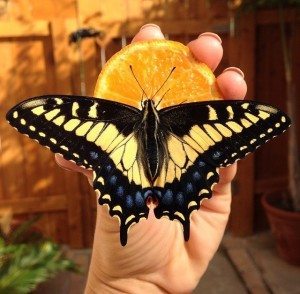 ^^^^^This is an example of how I fed an orange to my anise swallowtail^^^^^
^^^^^This is an example of how I fed an orange to my anise swallowtail^^^^^
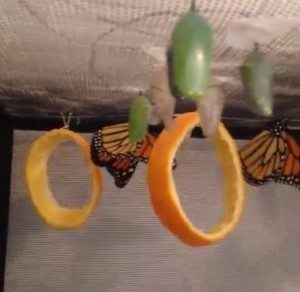 ^^^^^Hanging Orange Slices^^^^
^^^^^Hanging Orange Slices^^^^
If it is clear the next day, it is recommended to release them at 70 degrees outside. In Southern California, it is monarch season year round, so 60-degrees outside is fine in winter months.
Ok, how can you tell if it’s a male or female? With caterpillars, we don’t know. You would have to perform surgery, and that would kill it, so we don’t want to do that. We can tell once their chrysalis has hardened, but the easiest way to tell is to wait until it has emerged from it’s chrysalis. Let me show you, it’s super easy:
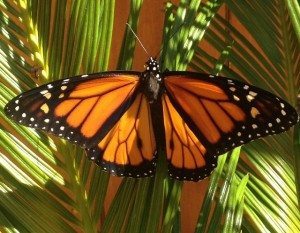 This is one of my males. You can tell by the 2 black dots (scent glands) on it’s hind wings.
This is one of my males. You can tell by the 2 black dots (scent glands) on it’s hind wings.
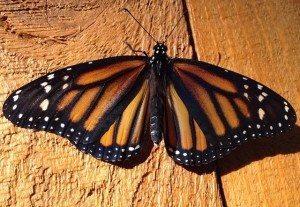 This is one of my females. She has no scent glands. The black veins in her wings are a lot larger than males as well.
This is one of my females. She has no scent glands. The black veins in her wings are a lot larger than males as well.
You may have some butterflies struggle to come out of their chrysalis. Maybe their wings are sticking to the shell of the chrysalis. It’s alright to provide a little assistance. Once they’re out, just hang them upside down. If you notice they’ve been hanging for awhile, yet their wings still did not open all the way, this is an indication of OE. You will want to separate it from the others so as to not spread the OE spore. It is not recommended to release the OE infected butterflies, so keep it indoors as a pet. Feed it, and it will only live a couple weeks if that.
Once your butterflies have been released, it’s time to clean out the cages or habitats. Use some bleach water and soap, scrub really good to get rid of all the bacteria, (I use a scrub brush with a bowl of soapy water and a spray bottle with bleach water, dip my brush in the soapy water, and spray my brush. Then I just scrub away and then rinse with the hose. Let it dry or hand dry, and your habitat is ready for the next batch. ***VERY IMPORTANT*** Be sure to sterilize your cages after each batch. If they are not sterile and cleaned, then the next batch of monarchs may ingest bacteria from the prior batch and will not make it.
I hope this was helpful! These are just basic how-to instructions on how to raise monarch butterflies. I learned this all on my own via trial and error. If you’re just starting out, you’re way ahead of me when I started since you now know exactly what to look for now.
If you have any questions, feel free to comment below. And don’t feel bad if you lose a few caterpillars here and there. Keep in mind that only 10% survive outside on their own. Bringing them inside, having even half of them make it, bumps that 10% up to 50%. You’re doing a good thing. We need to bring back the monarch population to help our pollinators. I can’t wait to hear how your babies do! Send me photos and ask me questions! Go save some monarchs!

